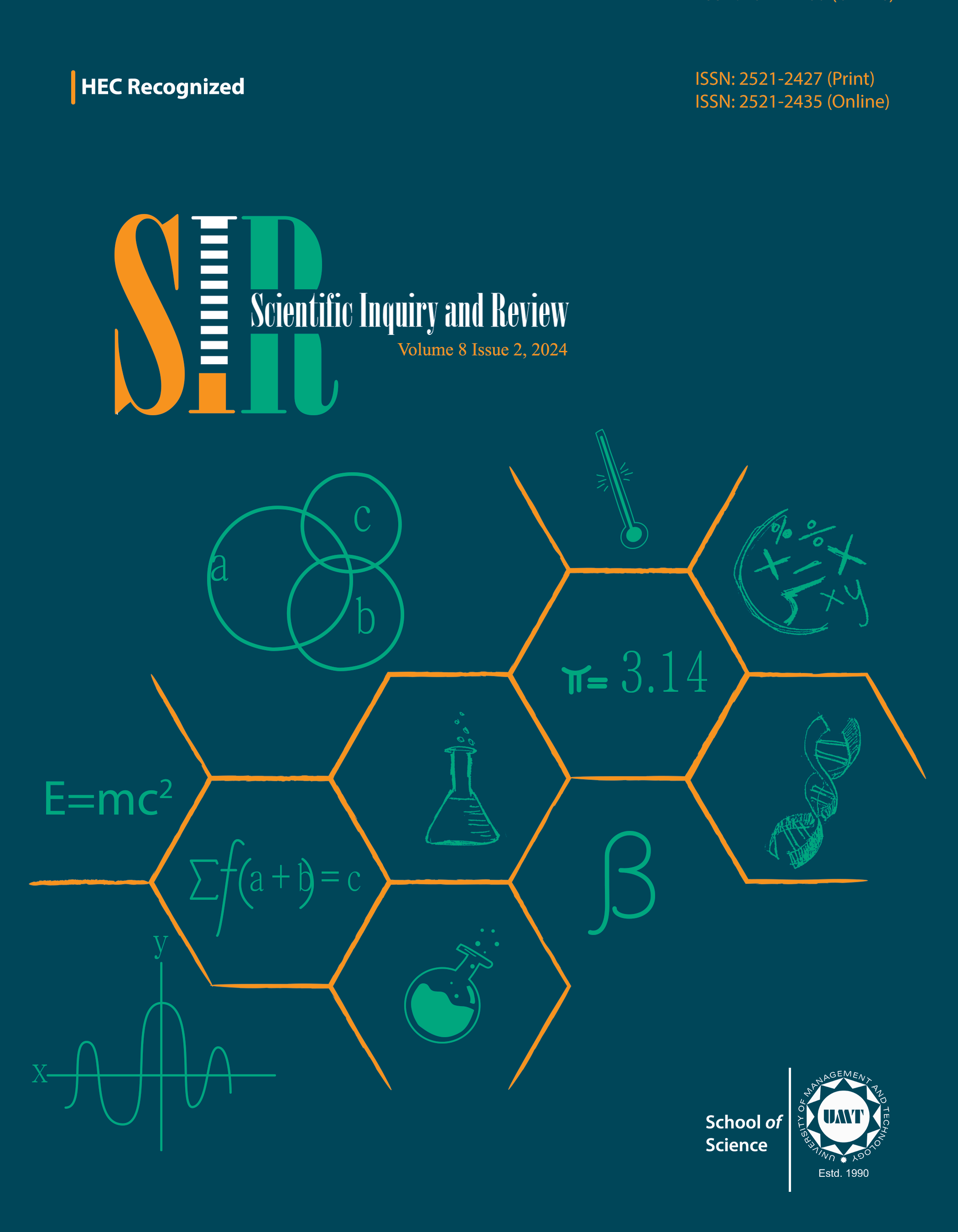Extraction, Characterization, and Biological Activity of Volatile and Non-volatile Components of Grapefruit
Abstract
 Abstract Views: 0
Abstract Views: 0
Grapefruit (Citrus X paradisi) is among the biggest and most popular fruit crops grown for profit, worldwide. It is not only economically essential but also remains a popular human dietary ingredient. There are numerous varieties of citrus, all coming with vibrant colors. Both processed and fresh forms are consumed. Half of the fruit, including seeds, peels, and pith remnants are inedible and wasted after processing. Pectin, essential oils, citric acid, flavonoids, and other significant phytochemicals derived from citrus are currently widely studied in food, industrial, and synthetic chemistry. This study examines the properties of flavonoids derived from citrus leaves, their extraction process, and their usage with respect to potential health advantages. Using GC-MS/MS, the flavonoids content of grapefruit leaf extracts was determined. It was found that the primary flavonoid present in grapefruit pulp, oven-dried leaves, and fresh leaves was isonaringin. In new experiments, fresh and dried leaves of grapefruit (dried at 45°C) showed a potent cytoprotective effect on neuroblastomas SH-SY5Y. According to the data, bioactive flavonoids are naturally found in fruit leaves that can be used as remedy in many therapeutic and antibacterial activities.
Downloads
References
Bailey DG, Dresser G, Arnold JM. Grapefruit–medication interactions: forbidden fruit or avoidable consequences. Can Med Assoc J, 2013;185:309–316. https://doi.org/10.1503/cmaj.120951
Bailey DG, Malcolm J, Arnold O, Spence JD. Grapefruit juice–drug interactions. Br J Clinic Pharmacol. 1998;46(2):101–110. https://doi.org/10.1046/j.1365-2125.1998.00764.x
Bailey DG, Dresser GK, Bend JR. Bergamottin, lime juice, and red wine as inhibitors of cytochrome P450 3A4 activity: comparison with grapefruit juice. Clinic Pharmacol Ther. 2003;73(6):529–537. https://doi.org/10.1016/S0009-9236(03)00051-1
Svoboda KP, Greenaway RI. Lemon scented plants. Int J Aromather. 2003;13(1):23–32. https://doi.org/10.1016/S0962-4562(03)00048-1
Chen M, Zhou SY, Fabriaga E, Zhang PH, Zhou Q. Food-drug interactions precipitated by fruit juices other than grapefruit juice: an update review. J Food Drug Anal. 2018;26(2):S61–S71. https://doi.org/10.1016/j.jfda.2018.01.009
Saito M, Hirata-Koizumi M, Matsumoto M, Urano T, Hasegawa R. Undesirable effects of citrus juice on the pharmacokinetics of drugs: focus on recent studies. Drug Safety. 2005;28:677–694. https://doi.org/10.2165/00002018-200528080-00003
Schulich. Dr. David Bailey finds new reason to avoid fruit juices when taking drugs. Schulich Web site. https://www.schulich.uwo.ca/schulichhome/articles/2008/08/20/dr-david-bailey-finds-new-reason-to-avoid-fruit-juices-when-taking-drugs.html. Updated August 20, 2008. Accessed November 11, 2023.
Greenblatt DJ, von Moltke LL, Harmatz JS, et al. Time course of recovery of cytochrome p450 3A function after single doses of grapefruit juice. Clinic Pharmacol Therapeut. 2003;74(2):121–129. https://doi.org/10.1016/S0009-9236(03)00118-8
Mitchell S. Why grapefruit and medication can be a dangerous mix. Yahoo News Web site. https://tinyurl.com/2p8ssa8h. Updated February 20, 2016. Accessed November 11, 2023.
Pirmohamed M. Drug-grapefruit juice interactions. BMJ. 2013;346:ef1. https://doi.org/10.1136/bmj.f1
Bailey DG, Spence JD, Munoz C, Arnold JM. Interaction of citrus juices with felodipine and nifedipine. Lancet. 1991;337(8736):268–269. https://doi.org/10.1016/0140-6736(91)90872-M
Bakalar, N. Experts reveal the secret powers of grapefruit juice. New York Times. March 21, 2016. https://www.nytimes.com/2006/03/21/health/experts-reveal-the-secret-powers-of-grapefruit-juice.html. Accessed November 15, 2023.
Edwards DJ, Bernier SM. Naringin and naringenin are not the primary CYP3A inhibitors in grapefruit juice. Life Sci. 1996;59(13):1025–1030. https://doi.org/10.1016/0024-3205(96)00417-1
Calvarano M, Postorino E, Gionfriddo F, Calvarano I, Bovalo F. Naringin extraction from exhausted bergamot peels.
Perfum Flav. 1996;21(5):1–4.
Paine MF, Widmer WW, Hart HL, et al. A furanocoumarin-free grapefruit juice establishes furanocoumarins as the mediators of the grapefruit juice–felodipine interaction. Am J Clinic Nutr. 2006;83(5):1097–1105. https://doi.org/10.1093/ajcn/83.5.1097
Veronese ML, Gillen LP, Burke JP, et al. Exposure-dependent inhibition of intestinal and hepatic CYP3A4 in vivo by grapefruit juice. J Clinic Pharmacol. 2003;43(8):831–839. https://doi.org/10.1177/0091270003256059
Tassaneeyakul W, Guo LQ, Fukuda K, Ohta T, Yamazoe Y. Inhibition selectivity of grapefruit juice components on human cytochromes P450. Arch Biochem Biophys. 2000;378(2):356–363. https://doi.org/10.1006/abbi.2000.1835
He K, Iyer KR, Hayes RN, Sinz MW, Woolf TF, Hollenberg PF. Inactivation of cytochrome P450 3A4 by bergamottin, a component of grapefruit juice. Chem Res Toxicol. 1998;11(4):252–259. https://doi.org/10.1021/tx970192k
Garg SK, Kumar N, Bhargava VK, Prabhakar SK. Effect of grapefruit juice on carbamazepine bioavailability in patients with epilepsy. Clinic Pharmacol Therapeut. 1998;64(3):286–288. https://doi.org/10.1016/S0009-9236(98)90177-1
Bailey DD, Dresser GK. Interactions between grapefruit juice and cardiovascular drugs. Am J Cardiovascul Drugs. 2004;4:281–297. https://doi.org/10.2165/00129784-200404050-00002
Bressler R. Grapefruit juice and drug interactions. exploring mechanisms of this interaction and potential toxicity for certain drugs. Geriatrics. 2006;61(11):12–18.
Espina L, Somolinos M, Lorán S, Conchello P, García D, Pagán R. Chemical composition of commercial citrus fruit essential oils and evaluation of their antimicrobial activity acting alone or in combined processes. Food Control. 2011;22(6):896–902. https://doi.org/10.1016/j.foodcont.2010.11.021
Ayoola GA, Johnson OO, Adelowotan T, et al. Evaluation of the chemical constituents and the antimicrobial activity of the volatile oil of Citrus reticulata fruit (Tangerine fruit peel) from South West Nigeria. Afr J Biotechnol. 2008;7(13):2227–2231.
Bailey DG. Fruit juice inhibition of uptake transport: a new type of food–drug interaction. Br J Clinic Pharmacol. 2010;70(5):645–655.
Lundahl J, Regårdh CG, Edgar B, Johnsson G, Relationship between time of intake of grapefruit juice and its effect on pharmacokinetics and pharmacodynamics of felodipine in healthy subjects. Eur J Clinic Pharmacol. 1995;49(1–2):61–67.
Copyright (c) 2024 Ayesha Zulifqar, Syeda Shaista Gillani, Hafsa Akhtar

This work is licensed under a Creative Commons Attribution 4.0 International License.






